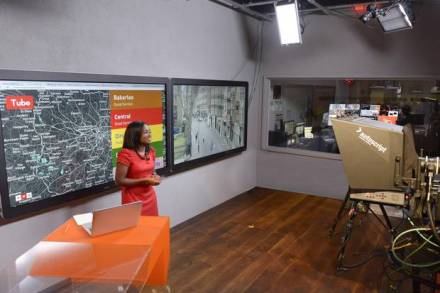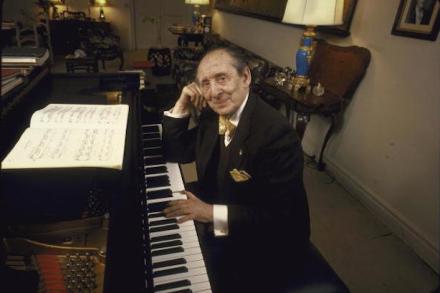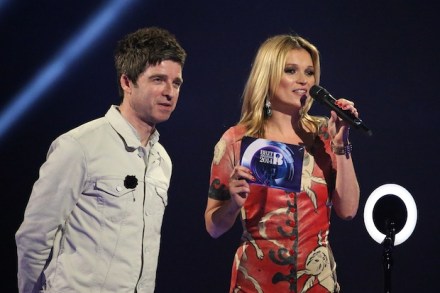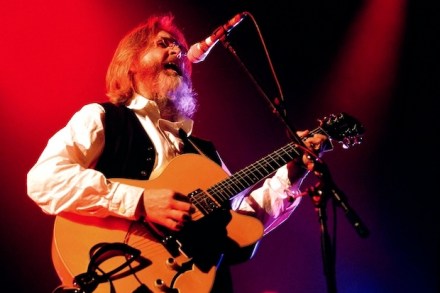Anthony Hopkins and a musical luvvie-fest
Has anything ever been more luvvie than this?

Our curation of music and opera reviews
Has anything ever been more luvvie than this?

W.H.Auden once wrote: ‘Real artists are not nice people. All their best feelings go into their work and life has the residue’ — which puts those who aspire to be artists in a bit of a quandary. Is it a measure of one’s success as a ‘real artist’ that one is not a nice person? Is it in fact possible to be a real artist and a nice person? And, if it is not, is it better to be a real artist or a nice person? Auden, who was speaking from first-hand experience, implies that it must be one or the other. By the time he wrote this, Auden was

So Lebedev’s London Live has launched. And I don’t know about you but I’m hooked. I’d totally forgotten what really bad TV looked like. It’s as if the chief execs at Channel 5 got together with Alan Partridge for a 21st-century rebrand. London’s new TV channel did get one nice review from the, oh, Lebedev-owned Independent – moving swiftly on. From what I’ve seen of London Live’s first full day, it’s as if a posh, ethnically very chic primary school won a Blue Peter competition where they got to dress up as adults for the day and run their very own TV channel – all by themselves! The top news story

‘The truth is,’ says Gordon Back, lowering his voice, ‘that if the violin finalists from the BBC Young Musician of the Year were to enter the Menuhin Competition, they wouldn’t make it to the first round.’ Not through the first round, note, but to the first round: they wouldn’t be good enough to compete. Back is artistic director of the Menuhin, held every two years in a different country. In effect, it’s a search for the next Yehudi Menuhin, who recorded the Elgar concerto with the composer at the age of 15. Some critics think Menuhin never quite fulfilled that astonishing early promise — but I wouldn’t dare suggest that

George Michael and Kylie Minogue have albums out this week. And while they might both be distinctly second-division these days, they’re both still rather remarkable. George Michael got famous for not being Andrew Ridgeley, and has since redefined the status of adult-oriented pop. He has also written the only Christmas song in history worth playing all year round and made the Hampstead branch of Snappy Snaps a tourist destination. I like him a lot. Minogue, meanwhile, is cheesy, knowing and resolutely budget in the international diva stakes. As Aldi is to Waitrose, so Kylie is to Beyoncé. But she’s made some terrific records – have you given up pretending you

Earworm: what a wonderful word. It describes, as nothing else quite can, the effect a really invasive melody can have on your consciousness. Hear the song once and you will hear it again and again, on a loop in your brain. At the pub quiz the other night, the answer to a question was Brotherhood of Man, and at least two of us subsequently suffered the torture of hearing ‘Save Your Kisses For Me’ in our heads for the rest of the evening. I don’t usually think of myself as Drinking To Forget, but this evening might have been an exception. So are people who love pop music more susceptible

listen to ‘Fraser Nelson on Britain’s 2014 Eurovision entry’ on Audioboo


Funny how quickly you forget the makeup of the average highbrow pop concert. It’s 96 per cent male, obviously, and very partial to a receding hairline-ponytail combo; last night’s performance by saxophonist and composer John Harle and former Soft Cell singer Marc Almond brought these types out to the Barbican in force. They were here to see The Tyburn Tree, a psychogeographical song cycle (!) based around London folklore and mysticism. Thus, whatever the evening promised, a degree of mass chin-stroking was inevitable. The audience sat down to complain about the quality of the craft beer on offer to their imaginary girlfriends, and the band began to tune up. This
One of the unlooked-for side effects of the financial crisis has been what might be called the desocialising of music funding. Whereas once many arts organisations could expect to survive solely on public money, just recently there has been an almost unseemly rush to tap private sources of cash. The time lag between the original catastrophe and the realisation that oblivion may be just round the corner is probably explained by the disinclination of politicians to dump high-profile organisations overnight. But now, finally, there is no escape. Philanthropists the world over are besieged. This would make such a lovely subject for a university student in the US, on one of

Some people have been pointing their cameras at the night sky. The results are rather special:

Having been whole-heartedly hacked off during the phone hacking scandal, one assumes that Sir Paul McCartney has always been an advocate of high standards in journalism. Not so. While collecting a gong for songwriting at the NME Awards last night, the former Beatle admitted trying to slip fake stories past the music magazine: ‘One of the things we used to like to try and do was to plant a false story in the NME,’ he said. ‘We actually got in with ‘George was Billy Fury’s cousin’, which he wasn’t. Living on the edge, man, you know what I’m saying?’ Someone send for Leveson.

Call me a fruitcake, but I am all for Islamic censorship when it comes to Katy Perry. In the last few days, there’s been a terrible fuss about Perry’s latest song, ‘Dark Horse’, because the video for it features an Arabic man wearing an ‘Allah’ pendant, who is burned alive. A bunch of angry Muslims, led by someone called Shazad Iqbal from Bradford, have campaigned against the video on the grounds that it was blasphemous. They launched a petition calling for the video to be removed from YouTube, and got more than 60,000 signatures. The video has now been edited to remove the offensive pendant, and Shazad has declared a victory

Victims of state persecution, ambassadors for day-glo knitwear and wank fodder for beardy liberals the world over, the members of Pussy Riot have been filling both prison cells and column inches since 2012. In the process, they’ve also become one of the most famous bands on the planet. But let me ask you this – have you ever actually heard any of their music? And crucially, is it any good? Was it purely their politics that led the Cossacks to attack them with horsewhips last week, or is that just the way they do pop criticism in the Caucasus? We took to the internet to get some balanced and entirely

Age has never been an impediment to great musicianship. YouTube is full of extraordinary late musical testaments from pianists who, refusing to retire, hit their stride in their eighth, ninth and, in Alice Herz-Sommer‘s unique case, tenth decades. Here is a selection of the finest: 1. Mieczysław Horszowski gave his first recital at the age of eight in 1900, his last at the age of 98 in 1991. He was present at the premiere of The Rite of Spring in 1913. He heard Busoni perform, played for D’Albert, Fauré and Saint-Saëns and was pals with Granados, Villa-Lobos and Szymanowski. His Chopin at the age of 98 in this Wigmore Hall recital

The 110-year-old pianist and oldest known Holocaust survivor, Alice Herz-Sommer, who was imprisoned in Theresienstadt concentration camp, has died. Her extraordinary life, which included childhood encounters with Gustav Mahler and Franz Kafka, latterly became the subject of several documentaries, the most recent of which, The Lady in Number Six, was this year nominated for an Oscar. A clip from it can be seen above. In a BBC interview with Judith Herman, Herz-Sommer chose some of her favourite recordings, many of which were made when she was in her 90s and are miraculous: More wit and wisdom and astonishing playing from the 105-year-old Herz-Sommer can be found in this clip from

It goes without saying that the Brits are not the draw they once were. But I was sick of being cynical about them. I sunk into my chair with the reservoir of alcohol I had bought and waited to witness something other than James Corden and mediocre musical performances. And did I? The fact that Ellie Goulding was named best British female solo artist should tell you everything. Of course I bloody didn’t. Unless you count David Bowie’s unionist shout out, delivered by a Kate Moss-shaped proxy, as inflammatory (it wasn’t), this junket was as boring and self-congratulatory as last year’s. And the year before. And the year before that.

Every time I hear that song ‘Sex & Drugs & Rock & Roll’ played on the radio, I think, Lord, how I miss Ian Dury. Then I wish they’d play something other than that plodder, especially when there are so many great songs of his to choose from. Some people knew all the words to Dark Side of the Moon; others to Sergeant Pepper; but we knew all the words to New Boots and Panties!!. And what words! He was our poet laureate. Put that record on and everybody would sing their heads off, especially to ‘Billericay Dickie’. ‘I bought a lot of brandy/ when I was courting Sandy/ took


I love a good hymn, so long as I’m not expected to sing it. Lusty declarations of faith sound ridiculous coming out of my mouth and embarrass the hell out of me, so I pretend that I’ve forgotten to pick up a hymnbook on my way in. If someone shoots me an accusatory glance, then I move my lips like John Redwood singing the Welsh national anthem. (Talking of whom, has it dawned on the jolly self-important Dr Redwood, former Fellow of All Souls, director of Rothschild’s, cabinet minister, etc., that one day he’ll be remembered only for that delicious video clip?) The earliest Christian hymns were chanted — but
Every musical career has its own narrative, and most of them include at least one comeback. To come back, you first have to go away; then you have to stay away; and finally, when everyone has forgotten your name, you wander nonchalantly back under the arc-lights and wave modestly to screaming fans and waiting reporters. Well, that’s the plan, anyway. As has been discussed here before, the gaps between record releases for all but the most irresponsibly prolific artists have become so wide that simply making another album becomes a comeback in itself. Thus has the currency of the comeback been devalued. Sometimes it feels as though there’s a different

Not long ago the great conductors of classical music were general practitioners. They expected to give satisfactory interpretations of music written from the beginnings of symphonic composition to the present day, and audiences took it for granted that, if they knew what they were doing with Mozart and Beethoven, they could be trusted with Handel and Stravinsky. Their orchestras adopted the same approach and, within a narrow definition that bespeaks a more innocent age, everyone was content. There was little concern that Handel would not have recognised the sound that the instruments of the modern orchestra was making; and no one was disturbed that the big hero figure out front
